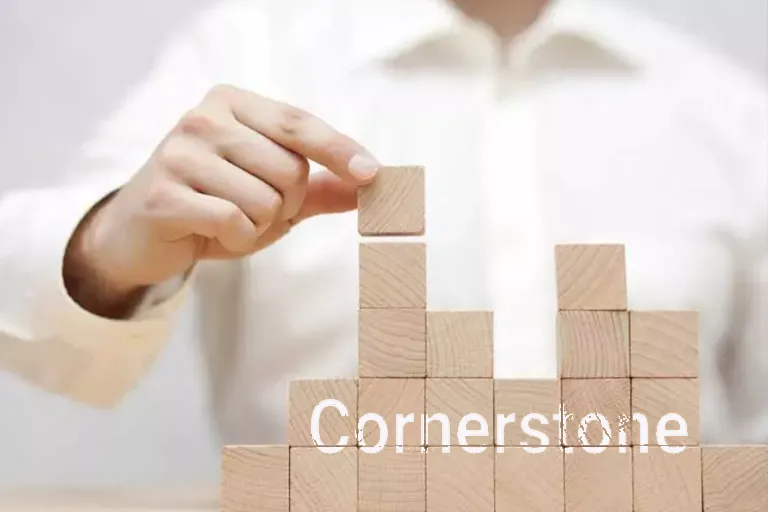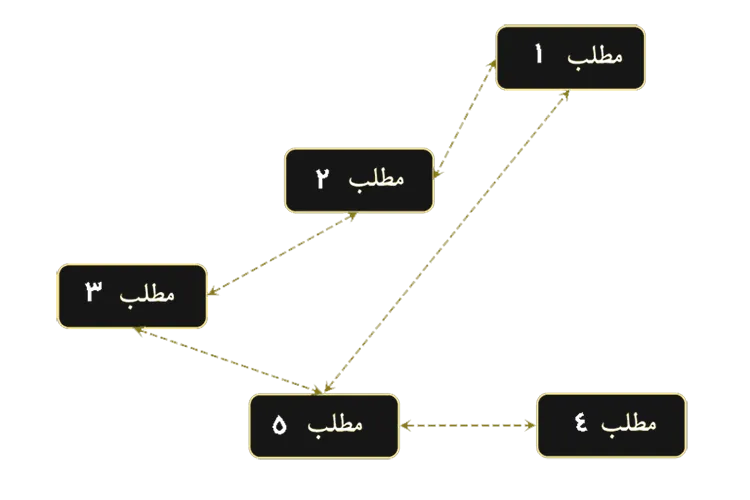If you intend to do internal linking in a professional way, it is appropriate to take the discussion of Cornerstone, which is sometimes known as the foundation stone or the root page, seriously and address it in a more detailed way.
This discussion can be considered a subset of information architecture and one of the first steps in structuring content on a site or blog.
When you hear or read the term Cornerstone, you shouldn’t feel like you’re dealing with a complicated concept. The fact is that even if you have never heard this term before in SEO or content strategy , it is still possible that you have unconsciously designed and implemented such pages.
Cornerstone concept
Suppose you write an article about introducing a book in your blog. Some time later, you decide to express one of the chapters of the book that was interesting to you in the form of a new article. Probably, after receiving the comments of your friends, you decide to write an article in response to some of the ambiguities raised.
As you can see, the number of articles you have published around a fixed topic has gradually increased. Here is a traditional way to link these things together. It is to specify and determine the relationship with other materials at the beginning and end of each article.
By doing this, you relate each article to one or more of your other articles and finally, a network of articles is formed. The diagram below shows a hypothetical example of creating a relationship between five different topics:
Cornerstone feature
The feature of this way of publishing content and connecting them to each other is that none of these five content is considered key. All of them are more or less at the same level and each one has referred to one or more other articles.
If you want to refer to this series of articles, you have two options:
- Or you should give a link to the first article, the study of which does not necessarily provide the audience with the big picture of the discussion.
- Or you should put the same tag on all of them and give a link to that tag, in this case it is not clear which article the audience should choose to start reading.
The more professional way is what is known as the Cornerstone or the foundation stone and sometimes as the fundamental content or the Cornerstone and it can also be called the root page.
In this way, you set up a sixth topic and in it, you state the general topic of the discussion and the other five topics and their relationship with each other:

Of course, Cornerstone is not always going to be produced during this process and after producing several related articles and confusing the audience among them. For example, you may design and publish Cornerstone from the beginning, and then gradually produce the content presented in it and provide it to the audience .
Also, on sites that are not constantly updated, Cornerstone can be part of the website design process . This means that the website designer defines several main Cornerstones based on his experience and business needs and tries to produce and present several articles for each of them.
The difference between Cornerstone and Landing Page
The landing page is the entrance gate to your space and as the name suggests, these pages are where visitors enter the site.
The landing page is not necessarily the bedrock of your content.
For example, when you advertise a product for sale , you might consider a dedicated landing page for it and introduce that page to your audience. Here the functionality of the page is not close to the definition we provided of Cornerstone.
Benefits of using indexed content
The first benefit of using Cornerstone is navigation. Because the root page or foundation stone can help the user to find his/her favorite content more easily and also understand and recognize its place in the content structure when using a content.
In addition, by using Cornerstone, you help your audience to better evaluate your site and content.
The audience who reads one or two articles of yours, may simply not realize that they are facing one of the scattered articles on your site or that you have really dealt with that topic in a specialized and extensive manner.
But if the Cornerstone is designed with care and patience, it can tell the audience what volume and depth of content they are facing, and based on this, your audience can make the right decision about repeated reading and subsequent visits to your site.
The importance of Cornerstone in site SEO
Using Cornerstone can help you capture keywords that have heavy competition.
You can get long sentences and phrases with specialized articles and materials. But for short words, using Cornerstone can increase your chances. Of course, on the condition that you have enough articles and types of specialized and useful content in that field, and you follow the principles of SEO and make sure that the level, variety and accuracy of your content satisfy the audience who reached the Cornerstone on the recommendation of the search engine. It provides
In addition to the above points, if Cornerstone is designed in a professional way, the probability that the audience will click on one of its contents will increase, and in this way, the depth and click rate of the audience will increase and the bounce rate will decrease.
Key points about the cornerstone
Here, like most SEO topics and topics, we come to a part where taste and experience are involved. So, what follows is based on my experience.
Due to the experimental nature of this discussion, it is likely that other people will have a different view and advice about it.
1- Creating Cornerstone as needed
For a niche site that only focuses on a very specific topic, a Cornerstone might be enough.
But if you have a variety of topics or your site, despite being specialized, has planned and reviewed many subcategories of the topic, it is more appropriate to consider several Cornerstones on your site.
Suppose someone has a website where he discusses religions and their theories.
At least what comes to mind is that after a few hundred articles, the following Cornerstones should be present on the site:
- Religious theorists
- Religious schools
- Religious books
- Analyzes of religions
But let’s not forget that Cornerstone makes sense when diverse and appropriate content is produced or is included in your production plan. Otherwise, the presence of Cornerstone can only remind the audience that the site is empty and lonely.
2- Not paying attention to the size and number of words
Many sites provide statistics and based on them, they say that if you want your Cornerstone to be favorable in terms of search engines and get a good rank, you must try not to have less than a certain amount of words or more than a certain amount.
Experience has shown me that it is better not to take such recommendations seriously and think about the same fundamental principle of SEO, which is to satisfy and provide the opinion of the audience.
Sometimes, lengthening the content will reduce the density of keywords in it and dilute the content, and this issue will have a negative impact on the evaluation of your page by search engines.
On the other hand, being short can question the comprehensiveness of your article, which is another weakness.
Anyway, you have some articles about a specific topic and you should introduce those articles in a proper and appropriate way in Cornerstone.
So instead of getting involved in technical games, just think about how you can explain that content to your audience in a meaningful way.
The result of this effort can be 500 words or 15,000 words, and no one can provide you with a predetermined version and impose a limit on you.
3- Linking to Cornerstone
Despite its simplicity, this point is sometimes overlooked.
For example, if we have a Cornerstone called SEO. It is important to remember that wherever we talk about SEO, it must be linked to this Cornerstone.
By doing this, you will increase page views and gradually introduce that page to your audience as a key page, and based on audience visits and your links, search engines will realize that that page is important and give it more weight.
4- Index pages are not listed
Even a simple list is better than no list at all. But try not to make your Cornerstone just a directory of links.
Give a little explanation for each article and describe the relationship between the articles.
Also, mention any point that you think is useful for the audience to know before moving on to other content.
The tags and categories themselves are a lot like a list and if you don’t provide more and more complete descriptions, you haven’t gone much beyond this level.
5- Continuous updating of the foundation stone
It often happens that after a while, you forget to go for the Cornerstone. So, if you have designed a checklist for content creation , which of course is reasonable to do, one of the points of your checklist must be to put the link and description in Cornerstone after publishing the new article.
6- Attention to the visual aspects of the root page
This tip isn’t unique to Cornerstone, and in fact, it’s important for anything you publish on the web.
Whenever you see that your article is long, use graphic elements to make it more readable.
You may do this by changing the font, using images, bolting, framing, or any other method. It is important that in long pages, the audience can easily look at the entire content and understand its structure, which is called skimming .
7- The usefulness of Cornerstone
Suppose someone reached your Cornerstone by searching on Google and has no intention of clicking on any other page.
The ideal situation is to start a little work on the same page and give him general ideas.
Of course, following this advice is not always possible. But if you can meet it, don’t hesitate to use it. Lots of links and the opportunity to click and help to get to different pages is valuable. But the most valuable thing is that even without clicking, no one leaves your site empty-handed.
8- Linking to other sites
You can find many people today that their SEO knowledge is still based on the first and second generation of SEO algorithms and they do not have much understanding of the behavior patterns of the audience in search engines.
A good metaphor for the user’s interaction with the search engine is a conversation. The user talks to the search engine in successive searches.
Suppose he searched for a phrase and reached your site and the content was not enough for him. In this case, he goes to the search engine again and chooses another site. In this case, the search engine understands that you have not been able to complete his work, and for this reason, the audience has asked his question to the search engine again.
If you are sure there is an article on another site that complements or is better than yours, don’t hesitate to link to it on Cornerstone. All your links are not supposed to be internal and you will reduce the bounce by forcing.
The fact that the visitor goes to a better link from within the Cornerstone is much more valuable than leaving your site. Go to Google and with its help, find the better link again.
Do you have other Cornerstone experiences to share with us?










